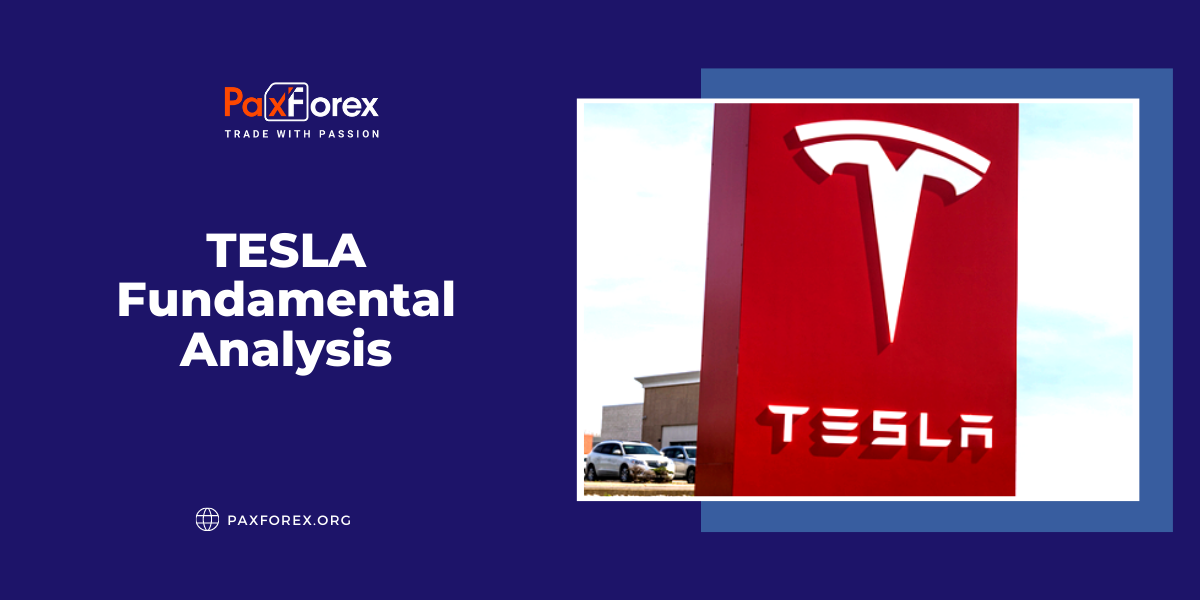
Source: PaxForex Premium Analytics Portal, Fundamental Insight
Tesla stock remains a top choice for growth investors, given its vast potential in various areas such as robot taxis, full self-driving vehicles, and other innovations envisioned by CEO Elon Musk. The market opportunities for Tesla are extensive and exciting.
However, a significant portion of its anticipated growth is already reflected in the current stock valuation. Tesla, being an electric vehicle (EV) manufacturer, carries an exceptionally high premium based solely on future expectations. While investors are keen on growth, they also recognize the need for substantial returns. Tesla investors, in particular, have enjoyed remarkable gains, turning a $10,000 investment five years ago into $104,000 today.
The question arises: Can Tesla stock double in the next five years? To answer this, let's explore the key factors that would be necessary for such an ambitious growth projection.
Presently, Tesla boasts a market capitalization of approximately $800 billion, and doubling this valuation would bring it on par with industry giants like Alphabet or Amazon. While this represents a substantial leap for Tesla, it remains a plausible scenario if various factors align favorably.
One of the significant challenges facing Tesla is a decline in profit margins. To maintain competitiveness in the electric vehicle (EV) market and match the monthly payment rates of other vehicles, Tesla has consistently reduced its prices, impacting its margins over the past year.
Heading into 2024, Tesla faces additional challenges due to new regulatory standards enacted through the Inflation Reduction Act. Under these standards, EVs qualify for the full $7,500 federal tax credit only if a certain percentage of their battery materials are sourced and built domestically. With rising thresholds, starting in 2024, some Tesla EV buyers will only receive a $3,750 credit. The potential impact on Tesla's sales remains uncertain, and whether the company will offset this tax credit reduction by further price cuts is yet to be determined.
Despite these challenges, Tesla's strategy of price reductions to bolster sales has proven effective. In Q3, the company produced 430,000 vehicles (an 18% year-over-year increase) and delivered 435,000 (a 27% year-over-year increase). These robust growth figures, coupled with the commencement of Cybertruck deliveries, are expected to contribute to overall production growth over the next five years.
In 2021, Tesla articulated its ambition to achieve a compounded annual growth rate (CAGR) in deliveries of 50%, a commitment it maintains despite potential fluctuations from year to year. Based on the last twelve months' delivery figure of 1.793 million, this projection implies Tesla could deliver a staggering 13.6 million vehicles annually. If realized, this figure would surpass the combined annual deliveries of Ford and General Motors.
While this may seem ambitious, it's crucial to note Tesla's robust presence in Europe and China, competing in significantly larger markets. Elon Musk has also expressed a goal of producing 20 million vehicles annually by 2030, contributing to the potential feasibility of the 13.6 million-vehicle target.
Considering global vehicle sales of approximately 58 million in 2022, Tesla's envisioned deliveries would account for nearly one-quarter of the global market. In Q3, Tesla's revenue per automotive delivery stood at around $45,000, with expectations for this figure to rise due to potential price increases and the introduction of higher-priced models like the Cybertruck.
Assuming Tesla achieves its previous peak margins of about 15%, it could generate earnings of $128 billion with an estimated revenue of $850 billion in 2028. Calculating the forward valuation needed for the stock to double ($1.6 trillion) by dividing it by the projected earnings suggests a valuation of 12.5 times earnings, a notable decline from its current valuation of approximately 79 times forward earnings. Even if Tesla falls short of its ambitious goal and achieves two-thirds of the projected deliveries (about 9 million), it would still trade at a reasonable 20 times earnings.
These projections do not even account for other technological advancements such as full self-driving, semi trucks, or robo taxis, adding further factors to consider. While the achievement of these goals remains challenging, the possibility of Tesla doubling its stock in five years is not out of the question, contingent on robust margins and achieving forecasted growth rates.
As long as the price is above 230.00, follow the recommendations below:
- Time frame: D1
- Recommendation: long position
- Entry point: 260.78
- Take Profit 1: 277.00
- Take Profit 2: 298.00
Alternative scenario:
If the level of 230.00 is broken-down, follow the recommendations below:
- Time frame: D1
- Recommendation: short position
- Entry point: 230.00
- Take Profit 1: 220.00
- Take Profit 2: 208.00













